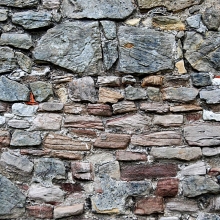Manufactured Stone Masonry
Manufactured stone masonry, sometimes known as cultured stone or thin stone, refers to a wide variety of synthetic cast stones that are used as a finish veneer in both exterior and interior applications. Stone walls and assemblies have long projected a natural, warm, and earthy feeling. However, the expense of building with natural stone has limited its use to projects with a big budget and a desire for permanence. But manufactured stone, with its realistic-looking design elements, can provide the aesthetics of stone with less material and labor costs and less structural impact.

Topic Summary
Manufactured stone is made by casting a mixture of portland cement, aggregate, and blended pigments in a large variety of molds. Molds are designed to simulate many varieties of natural stone, with limestone, fieldstone, ledgestone, and river rock being popular styles. Stone sizes can range from small, finger-sized pieces (1"x2") to large flat stones as big as 20" x 20." Corner pieces are carefully designed to provide the illusion of thicker, more traditional stone. Special shapes are also available, offering design flexibility for window and door surrounds, arches, cap stones, and other trim. The wide variety of styles and ease of installation make manufactured stone a realistic option for almost any exterior or interior surface. Among the typical exterior applications are veneered wall surfaces, columns, archways, and landscaping walls and fences. Interior applications of manufactured stone are typically veneered wall surfaces, fireplace veneers, and accent panels.
While manufactured stone can be used almost anywhere that natural stone could be used, the installation process is quite different. Manufactured stone is a veneer that is adhered directly to the backing substrate with a stucco scratch coat and mortar. Natural stone assemblies, like unit masonry, are constructed to bear upon the stones below. The adhesion or bonding of the stone units and the drainage of the exterior assemblies are the primary concerns in the detailing of a manufactured stone installation. The stucco coat and mortar used to bond the stones to the subsurface must achieve the proper chemical reaction to ensure a long-lasting bond. As the stones and mortar are still basically pourous materials, water can penetrate the assembly, making a drainage system necessary. Manufactured stone can be installed over substrates of plywood, board insulation, and cement board, which are covered with a layer of felt paper to prevent water from migrating into the substrate. Special felt papers are available with channels that allow moisture to drain to a weep system at the base of the assembly.
Additional Info
- External Link: Manufactured Stone Installation
- Description: Related article from AskTheBuilder.com discussing the proper technique and stucco mixture from adhesion of manufactured stone veneer
- External Link: Eldorado Stone
- Description: Vendor site with many design and product images and a large library of installation techniques
- External Link: Owens Corning Cultured Stone
- Description: Vendor site with product line description, technical information, installation videos and photo gallery
- External Link: Cultured Stone Best Practices Flashing Details
- Description: Flashing detail drawings and best practices provided by Owens Corning Cultured Stone
- External Link: Manufactured Stone Technical Bulletin
- Description: Technical bulletin from ABCO Construction Services on the proper detailing of manufactured stone veneer systems for weather resistance
- External Link: National Gypsum - Permabase
- Description: Product link for National Gypsum Permabase cement board sheathing for cultured stone and thin brick veneers with assembly detail drawings

Buildipedia Staff
The Buildipedia research and writing staff consists of dozens of experienced professionals from many sectors of the industry, including architects, designers, contractors, and engineers.
Website: buildipedia.com/ Email This e-mail address is being protected from spambots. You need JavaScript enabled to view it


